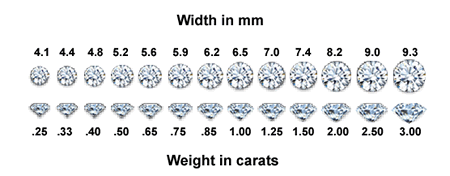Diamonds are the most expensive gem and when shopping for it you need to look at the basic attributes that are highlighted in the diamond's 4C’s – cut, color, clarity and carat.
Cut: A cut defines the facet arrangement of diamond that is further called as Shape. People get confused with cut and shape. But, they are two different aspects of the same coin. Basically, the craftsman shows his skills by arranging the facet of the stone in such a way that the light which enters through diamond should get reflected directly back to the viewer's eye.
Diamond cutters are solely responsible to make or break the light that enters through the stone. Hence, too shallow or too deep cut can cause light to "leak" out from the sides and bottom of the diamond.
GIA has set parameters that evaluate diamond cut and grade them as follows:
* Ideal
* Premium
* Very Good
* Good
* Fair and Poor.
The better the Cut grade, the more expensive is the diamond.
Color: Here the color refers to the transparency of the gem, because colorless diamonds are more valuable than a colored stone. With the exclusion of "fancy colored diamonds", colorless diamonds are very rare and highly in demand. Diamond color has been graded on a GIA scale from D (colorless) to Z (light yellow).
Clarity: It refers to the internal flaws that are called as inclusions such as small flaws, air bubbles, scratches, tint or other minerals within the diamond. The inclusion of diamond would result on its price. However, diamond with less inclusions is more precious and attractive.
The scale for grading diamond's clarity is:
F Flawless – No inclusions.
IF Internally Flawless - Slight inclusions in the exterior of the gem.
VVS1-VVS2 Very Very Slightly Included - minute inclusions that are very difficult to detect on 10x magnifications loupe.
VS1-VS2 Very slightly included - tiny inclusions, invisible to the naked eye and can only see through the 10x magnification loupe.
SI1-SI2 Slightly included - invisible to the naked eye, yet easily visible under 10x magnifications.
I1-I3 Included - inclusions are visible to the naked eye and affect on its brilliance.
When deciding on clarity, people usually go with SI2 and VS1 diamonds, without knowing their differences. A diamond that falls between VVS2 to F is very rare and expensive so, make sure you select the stone with proper evaluations.
Carat: A carat refers to the size and actual weight of a diamond. One carat is equivalent to 200 milligrams. Carat is also evaluated in numerical values.
For example:
* One carat diamond equals to 100 points,
* One-half carat diamond is consider as 50 points
* Three-quarter carat diamond as 75 points and so on.
Big diamonds are more expensive than smaller one of the same quality because of its rarity. For example: one carat diamond is much more expensive than value of multiple small diamonds of the same quality and total carat weight.



